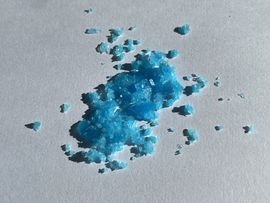Copper(II) perchlorate
 Crystals of copper(II) perchlorate hexahydrate
| |
| Names | |
|---|---|
| IUPAC name
Copper(II) perchlorate
| |
| Other names
Copper diperchlorate
Cupric perchlorate | |
| Properties | |
| Cu(ClO4)2 (anhydrous) Cu(ClO4)2·6 H2O (hexahydrate) | |
| Molar mass | 262.447 g/mol (anhydrous) 370.539 g/mol (hexahydrate) |
| Appearance | Blue crystalline solid |
| Odor | Odorless |
| Density | 2.225 g/cm3 (25 °C) |
| Melting point | 82 °C (180 °F; 355 K) |
| Boiling point | 100–102 °C (212–216 °F; 373–375 K) (decomposes) |
| 146 g/100 ml (30 °C) | |
| Solubility | Soluble in acetic acid, acetone, diethyl ether, ethanol, methanol |
| Solubility in furfural | 69 g/100 ml (20 °C)[1] |
| Vapor pressure | ~0 mmHg |
| Thermochemistry | |
| Std enthalpy of
formation (ΔfH |
-1,915 kJ/mol |
| Hazards | |
| Safety data sheet | Sigma-Aldrich (hexahydrate) |
| Related compounds | |
| Related compounds
|
Silver perchlorate |
| Except where otherwise noted, data are given for materials in their standard state (at 25 °C [77 °F], 100 kPa). | |
| Infobox references | |
Copper(II) perchlorate is an inorganic chemical compound, a salt of copper and perchloric acid. It has the formula Cu(ClO4)2, though it is more commonly encountered as hexahydrate, Cu(ClO4)2·6 H2O. Besides the hexahydrate, a heptahydrate, tetrahydrate and dihydrate are also known.[2]
Contents
[hide]Properties
Chemical
Copper(II) perchlorate decomposes when heated.
Physical
Copper(II) perchlorate is a hygroscopic blueish solid, soluble in water.
Availability
Copper(II) perchlorate is sold by chemical suppliers.
Preparation
Copper(II) perchlorate can be prepared by dissolving copper(II) oxide with perchloric acid.[3]
- CuO + 2 HClO4 → Cu(ClO4)2 + H2O
Basic copper carbonate has also been employed.[2] Copper metal must not be used as the reaction is claimed to be dangerous.
Another method involves repeatedly evaporating copper(II) nitrate in excess 60 % perchloric acid:[4]
- Cu(NO3)2 + 2 HClO4 → Cu(ClO4)2 + 2 HNO3
If perchloric acid is not available but other perchlorate salts are, addition of aq. copper(II) sulfate to aq. barium perchlorate can work:
- CuSO4 + Ba(ClO4)2 → Cu(ClO4)2 + BaSO4
According to one source in literature, anhydrous copper(II) perchlorate can be prepared by silver perchlorate in diethyl ether, followed by addition of copper(II) bromide. Silver bromide precipitates out of the solution, while copper(II) perchlorate can be obtained by evaporating the ether.[5] A different source indicates that copper(II) chloride can also be used, but no product is given.[6]
- CuBr2 + 2 AgClO4 → Cu(ClO4)2 + 2 AgBr
The anhydrous salt has also been prepared by treating basic copper carbonate with dichlorine hexoxide. The obtained chloryl salt is then decomposed in vacuum at 70 °C to obtain the anhydrous perchlorate. The product can be sublimed at 160 °C in vacuum. The anhydrous salt is very hygroscopic.[7] Other copper salts may also be used.[8]
Reaction of nitrosyl perchlorate with copper metal in dry acetonitrile is claimed to yield anhydrous copper(II) perchlorate.[9]
- 2 NOClO4 + Cu → Cu(ClO4)2 + 2 NO
Projects
- Make Bis(ethylenediamine)copper(II) perchlorate
- Compound collecting
Handling
Safety
Copper(II) perchlorate is a powerful oxidizer. Perchlorates are toxic.
Storage
Should be kept in a clean bottle, away from any reducing agents or combustible materials.
Disposal
Copper(II) perchlorate should be reduced to chloride and the copper recycled.
References
- Jump up ↑ Solubility Handbook. - T.1, Book.1. - M.-L.: IAN USSR, 1961 (Справочник по растворимости. - Т.1, Кн.1. - М.-Л.: ИАН СССР, 1961)
- ↑ Jump up to: 2.0 2.1 Gmelins Handbuch der Anorganischen Chemie, Kupfer Teil B 1, 8th edition 1958, p. 337-339
- Jump up ↑ Nagy, L.; Zsikla, L.; Burger, K.; Rockenbauer, A.; Kiss, J. T.; Journal of Crystallographic and Spectroscopic Research; vol. 19; nb. 5; (1989); p. 911 - 918
- Jump up ↑ R. M. Caven, G. Bryce, J. Chem. Soc. 1934, 515, https://doi.org/10.1039/JR9340000514
- Jump up ↑ Monnier, G.; Annales de Chimie (Cachan, France); vol. 2; (1957); p. 14 - 57 ; (from Gmelin)
- Jump up ↑ Dartiguenave, Michele; Dartiguenave, Yves; Guitard, Andre; Mari, Alain; Beauchamp, Andre L.; Polyhedron; vol. 8; (1989); p. 317 - 324
- Jump up ↑ F. Favier, S. Barguès, J. L. Pascal, C. Belin, M. Tillard-Charbonnel, J. Chem. Soc., Dalton Trans. 1994, 3119-3121 https://doi.org/10.1039/DT9940003119
- Jump up ↑ J.-L. Pascal, J. Potier, C. S. Zhang, J. Chem. Soc., Dalton Trans. 1985, 297-305, https://doi.org/10.1039/DT9850000297
- Jump up ↑ Ishiguro, Shin-ichi; Jeliazkova, Bojana G.; Ohtaki, Hitoshi; Bulletin of the Chemical Society of Japan; vol. 58; nb. 6; (1985); p. 1749 - 1754